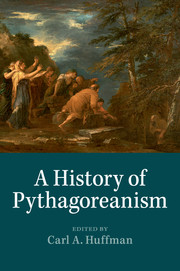Book contents
- Frontmatter
- Contents
- Contributors
- Abbreviations
- Introduction
- Chapter 1 Pythagoras
- Chapter 2 Philolaus
- Chapter 3 Archytas
- Chapter 4 Sixth-, fifth- and fourth-century Pythagoreans
- Chapter 5 The Pythagorean society and politics
- Chapter 6 The Pythagorean way of life and Pythagorean ethics
- Chapter 7 Pythagoreans, Orphism and Greek religion
- Chapter 8 The problem of Pythagorean mathematics
- Chapter 9 Pythagorean harmonics
- Chapter 10 The Pythagoreans and Plato
- Chapter 11 Aristotle on the “so-called Pythagoreans”: from lore to principles
- Chapter 12 Pythagoreanism in the Academic tradition: the Early Academy to Numenius
- Chapter 13 The Peripatetics on the Pythagoreans
- Chapter 14 Pythagoras in the historical tradition: from Herodotus to Diodorus Siculus
- Chapter 15 The pseudo-Pythagorean writings
- Chapter 16 Pythagoreans in Rome and Asia Minor around the turn of the common era
- Chapter 17 Diogenes Laertius’ Life of Pythagoras
- Chapter 18 Porphyry's Life of Pythagoras
- Chapter 19 Iamblichus’ On the Pythagorean Life in context
- Chapter 20 Pythagoras and Pythagoreanism in late antiquity and the Middle Ages
- Chapter 21 Pythagoras in the Early Renaissance
- Bibliography
- General index
- Index locorum
- Greek index
Chapter 8 - The problem of Pythagorean mathematics
Published online by Cambridge University Press: 05 May 2014
- Frontmatter
- Contents
- Contributors
- Abbreviations
- Introduction
- Chapter 1 Pythagoras
- Chapter 2 Philolaus
- Chapter 3 Archytas
- Chapter 4 Sixth-, fifth- and fourth-century Pythagoreans
- Chapter 5 The Pythagorean society and politics
- Chapter 6 The Pythagorean way of life and Pythagorean ethics
- Chapter 7 Pythagoreans, Orphism and Greek religion
- Chapter 8 The problem of Pythagorean mathematics
- Chapter 9 Pythagorean harmonics
- Chapter 10 The Pythagoreans and Plato
- Chapter 11 Aristotle on the “so-called Pythagoreans”: from lore to principles
- Chapter 12 Pythagoreanism in the Academic tradition: the Early Academy to Numenius
- Chapter 13 The Peripatetics on the Pythagoreans
- Chapter 14 Pythagoras in the historical tradition: from Herodotus to Diodorus Siculus
- Chapter 15 The pseudo-Pythagorean writings
- Chapter 16 Pythagoreans in Rome and Asia Minor around the turn of the common era
- Chapter 17 Diogenes Laertius’ Life of Pythagoras
- Chapter 18 Porphyry's Life of Pythagoras
- Chapter 19 Iamblichus’ On the Pythagorean Life in context
- Chapter 20 Pythagoras and Pythagoreanism in late antiquity and the Middle Ages
- Chapter 21 Pythagoras in the Early Renaissance
- Bibliography
- General index
- Index locorum
- Greek index
Summary
The first network of Greek mathematics
Before turning specifically to Pythagorean mathematics we need to consider the development of Greek mathematical culture as a whole. We all know the narratives where impersonal continuities replace individuals, for example, “The History of Greek Mathematics.” In fact, Greek mathematics, like most other ancient cultural endeavors, may have been pursued primarily by small networks that did not survive beyond two generations or so. A significant part of the Greek creative achievement in pure mathematics may be assigned to two such networks: the one found in Proclus’ summary of early Greek mathematics (In Eucl. 65.7–68.4 Friedlein), standardly understood to derive from Eudemus’ history of geometry, and the one constituted by Archimedes, his correspondents, and the authors in the following generation. It is the first network that is relevant to Pythagoreanism.
Proclus’ list includes three names from the archaic era: Thales, Mamercus and Pythagoras. Hippias of Elis, Anaxagoras and Oenopides are brought in based on their mention in Platonic dialogues; next follow Hippocrates of Chios, Theodorus of Cyrene, (Plato himself) and finally: Leodamas of Thasos, Archytas of Tarentum, Theaetetus of Athens, Neoclides, his pupil Leon, Eudoxus of Cnidus (a little later than Leon), Amyclas of Heracleia, Menaechmus (a student of Eudoxus), Dinostratus, his brother, Theudius of Magnesia, Athenaeus of Cyzicus, Hermotimus of Colophon and Philippus of Mende.
Keywords
- Type
- Chapter
- Information
- A History of Pythagoreanism , pp. 167 - 184Publisher: Cambridge University PressPrint publication year: 2014
- 3
- Cited by



